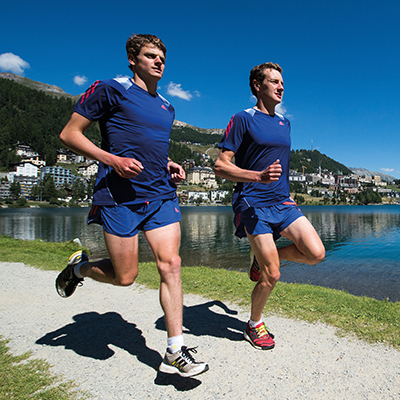When you’ve lived and trained in the hills of Yorkshire for most of your life, you can be forgiven for wanting a break now and again. For the Brownlee brothers, St Moritz, the idyllic resort town in Switzerland’s Engadin valley, has become something of a second home for the Olympic and Commonwealth Games medallists.
At 6,089ft above sea level, the destination boasts 360 miles of stunning trails and footpaths, making it the perfect place for training. The brothers are regular visitors to the location and are not the only elite athletes to take advantage of its training benefits. Mo Farah and Paula Radcliffe have both used St Moritz as a training destination.
In fact, you’re unlikely to take a walk without seeing a group of runners pacing alongside a lake or scurrying up a grass hill. The community is sport driven, and packed with world-famous Olympians and weekend club runners.
Keen to understand more about the benefits of training above the clouds, I caught up with the Yorkshiremen after an evening track session…
So, how does altitude training help you as athletes?
Alistair Brownlee (AB): The theory is that the air is thinner, the pressure of it is lower, so there is less oxygen going into your lungs. It’s like everything in training: you want to stress your body in a way that provides a stimulus, and your body reacts to that stimulus and effectively gets fitter.But training at high altitude is physically challenging, and it can take some time before your body is able to adjust to the thinner air.
Jonny Brownlee (JB): The first day you get here, you walk up the stairs carrying your bags and you think, “Wow, that was hard work.” The first run I do the next morning, I’ll be fine on the flat but as soon as I hit a hill, it’s really, really hard work.
Every time you breathe, you have to work harder. It feels easier after two or three days, although your times on a running track won’t be back to normal until seven or eight days after you’ve been here. So that’s why, ideally, it’s good to spend a decent amount of time here.
How long do you need to spend up here to reap the rewards?
AB: In theory – and even we can do the theory – you’d want to be up here for five or six weeks. You’d spend about 10 days to two weeks getting used to it and spend two blocks of two weeks training really hard. That’s the best-case theory, but it’s probably never going to happen. We can’t do it because of race schedules and most amateur people can’t do it because of work.
JB: Unless they have a cracking job!
How would amateur runners deal with altitude training?
AB: You’ll only feel the dizziness effect on the first couple of days. We’re talking about it in terms of doing tough training: hard swimming reps, long cycles and quick running. If you just go out for mid-paced run, you’re going to be able to handle it.
JB: On a track, you might run at 66-second pace at home and you’ll come up and maybe run at 68-second pace. So if a guy wasn’t used to doing that, then you’re going to get a great benefit from aerobic training. If you do any kind of week’s training here, and come down and train straight away afterwards, it will feel easier.
Your home of Yorkshire also has some great running trails. What motivates you to come out to St Moritz?
AB: Obviously, the scenery in Yorkshire is fantastic. But we’ve trained 30 to 35 hours a week there for several years, so I think
it’s good and important to change the scenery, go to different places and have that ‘training camp’ lifestyle where you don’t have anything else distracting you.
The way we train is unlike a lot of other athletes, who feel like training is a kind of chore. We enjoy it and are inspired by it,
so it’s great to go to a place like this.
JB: St Moritz is best place in the world for running, without a doubt. You can run up the hills if you want and take the cable car down. You can run on the flat, and the lakes are gorgeous too.
It’s not often you get places where there are well-built trails everywhere. There’s a running track in the middle of the town that anyone can use. We’ve seen everyone from Mo Farah to amateurs using it – often at the same time!
Switzerland is the official training destination of Human Race Events.
This article appears in the October isssue of Men’s Running. To get a copy, click here.






